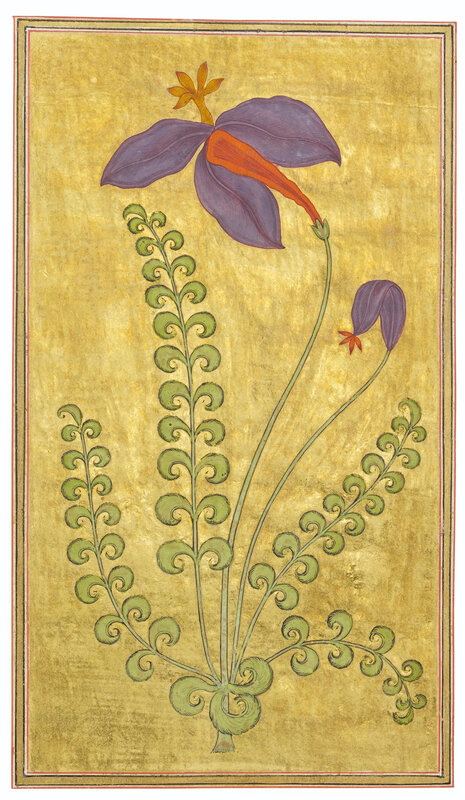Note: Further leaves from the same manuscript were exhibited at the Metropolitan Museum of Art (Haidar and Sardar, 2015, no.169, pp.292-3). The text refers to a previous exhibition that published further leaves and, one assumes, the colophon. The text contains three philosophical works by the long-lived maharaja of Jodhpur Jaswant Singh. He started out as a loyal ally of the Mughal emperor Shah Jahan but backed Dara Shikoh over Alamgir (Aurangzeb). Aurangzeb showered honours and titles on him to in his loyalty, and to assist in his military campaign against Shivaji in the Deccan (Bose, 2015, p.174).
This volume shows clearly the mix of influences that were all to be found throughout India at this time. The Hindu text is combined with Mughal-like flowers, but with an Deccani imaginary flavour and the Aurangabad gold ground. These are framed in borders that derive from the Ottoman cintamani design. Attributing the manuscript without the colophon would not be straightforward.
Christie's. Maharajas & Mughal Magnificence, New York, 19 June 2019

/https%3A%2F%2Fprofilepics.canalblog.com%2Fprofilepics%2F1%2F0%2F100183.jpg)
/https%3A%2F%2Fstorage.canalblog.com%2F03%2F02%2F119589%2F96711876_o.jpg)
/https%3A%2F%2Fstorage.canalblog.com%2F11%2F31%2F119589%2F94773502_o.jpg)
/https%3A%2F%2Fstorage.canalblog.com%2F20%2F83%2F119589%2F94772815_o.jpg)
/https%3A%2F%2Fstorage.canalblog.com%2F26%2F72%2F119589%2F75604929_o.jpg)
/https%3A%2F%2Fstorage.canalblog.com%2F59%2F60%2F119589%2F26458628_o.jpg)




/image%2F1371349%2F20240423%2Fob_b2fe42_telechargement-9.jpg)
/image%2F1371349%2F20240423%2Fob_af8bb4_telechargement-6.jpg)
/image%2F1371349%2F20240423%2Fob_b6c4a6_telechargement.jpg)
/image%2F1371349%2F20240423%2Fob_981d5f_h22891-l367411650-original.jpg)